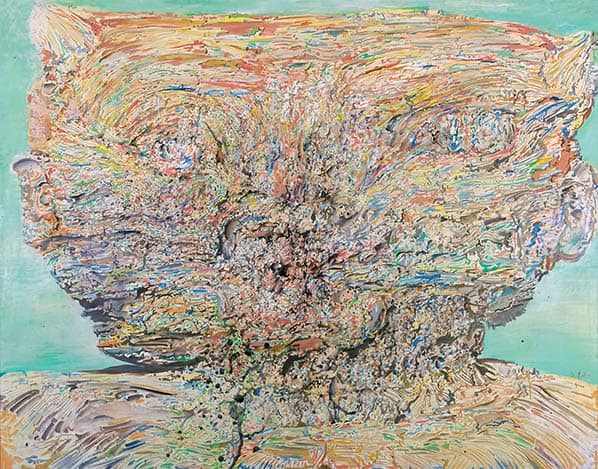Dado by Daniel Cordier
This text by Daniel Cordier is taken from the brochure Huit ans d’agitation, published in 1964 on the occasion of the last show at Daniel Cordier’s gallery.

Click on the images to enlarge them
(large and extra large sizes)
❧
Fullscreen
slideshow
I met Dado through Kalinowski in 1957. I was, I still am disconcerted by this small, bearded, untidy man with the soft voice and refined language at once mocking and sad, living in irremediable disorder and surrounded by owls, cats, sheep, and children.

Every Sunday on weekends I’d go and see Dado. He worked on three or four paintings simultaneously, for which the studies were always explicit and complete. Often, he abandoned the damaged, punctured image in a comer of his atelier, or he repainted it excessively until it was a tired and inoperable paste. Sometimes the miracle occurred, and extravagant figures descended onto the canvas and described admirably the melancholy of time which degrades all beings and all things.
Innumerable meticulous and perfect drawings lay scattered about the floor, shredded, torn, crumpled. There is practically not a single work by Dado which hasn’t had to be restored before being exhibited in public. I always told him in laughing that his hatred for his dealer made him ruin his work unconsciously in order to disgust me.

Dado’s art is one of serenity beyond despair. A concentrated universe where fallen man returns to his animal origins; world of atomic catastrophes where the genius of several men has served only to corrupt the minds and to mutilate the bodies of all others; drama of delivery where the innumerable residue, the defecations, the worn-out organs transform the-world into a fantastic hospital where beings endeavor in pain and in shame. The refined palette, lavender blue and tangerine rose, increases the nightmare through the preciosity of the staging. I am surprised when I hear his works criticized as morbid. Do they not reveal the reality surrounding us which we do not dare look at, ashamed as we are of our health, comfort, and indifference? If this painting of cataclysms, accusatory painting, appears to me to be the natural decor for my thoughts, it is perhaps because horror is my comfort.

oil on canvas, 80 cm.
Duško Vujošević Collection.
Photo: Vladimir Popović.
Dado’s painting is a painting of instinct, in which the paintbrush glides at the will of intuition, drawing, erasing and rebuilding the subjects it becomes aware of the moment it composes them.
It seems that human misery has taken refuge in his arms, transforming this frail, youthful-looking man into a colossal prophet of pity and horror.
If one is going to talk about a painter, it behooves one to address his technique, his themes, his inspiration; especially in our age, when these values have replaced others that half a century ago appeared outmoded, but whose absence after their protracted exile now begins to be felt. Thus one expatiates on a disincarnate object floating one knows not where, detached from both maker and beholder. Here and there, voices speak of the “new figuration,” and indeed the return of images from nature into painting does pose a visual problem.

oil on canvas, 80 cm.
With Dado, we are far from aesthetics, we are at the centre of a bleeding humanity, without literature, without complacency. His images are so upsetting (in the strongest sense – that is, they lodge in the memory), that, long after having gazed on them, we carry them in our hearts, like something remorseful.
It would be to the glory of this child-painter to have restored to painting the presence it lacked – a lack about to kill it, without anyone noticing.
Dado is the master of a “new humanization”. This is no “plastic problem”; it calls for heart, as well as a dose of genius.
Daniel Cordier



